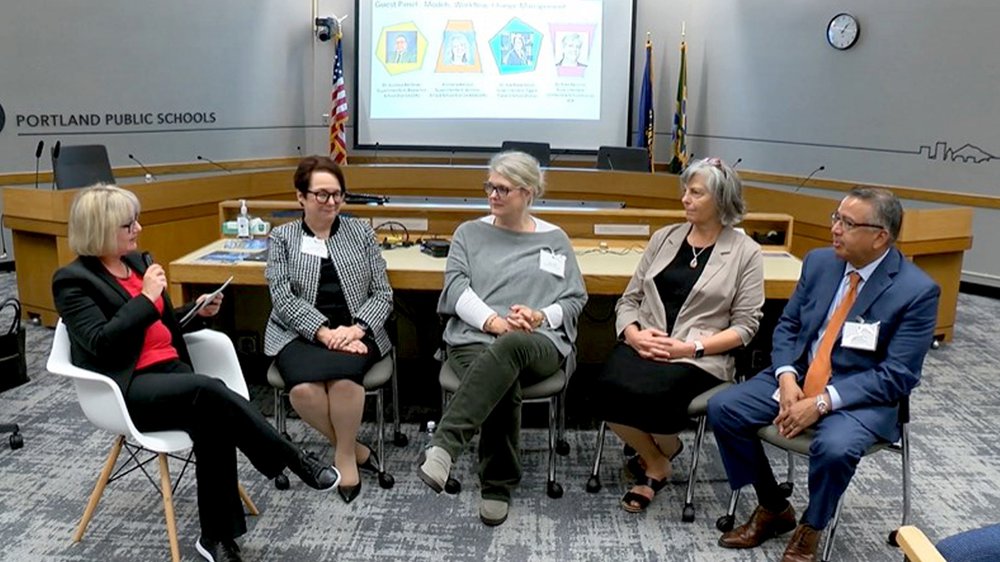Do you know about the Hybrid Logistics Project?
This is my journey to study logistics, small-batch manufacturing and time and space use, and apply them to a foster a whole new form of schooling.
Hundreds of thousands of fabulous educators out there in K12 have met me at one time or another as I toured America in 20-30 or more cities with Learning Counsel’s events tours for the past ten years. Or you’ve listened to my podcasts, read Special Reports or articles I’ve written, or seen me speak at large conferences like ISTE.
I am also the recent progenitor of a wildly novel idea called the Hybrid Logistics Project. Yet it wasn’t me alone, many of the very brightest minds in education contributed.
In the very beginning, Learning Counsel Media was to bring orderliness to the chaotic world of edtech, especially the software side. I was getting tons of press releases from ever increasing numbers of companies asking for news coverage. I knew a tidal wave had arrived on the shores of schools and they would be washed away with the confusion of it all. Many years were spent helping school leaders in their discernment of value in edtech. For example, in our first year in operation touring the country putting on events, Superintendents used giant Lego blocks with sticky labels to build their first goal-oriented Edtech Model Architecture. It was very productive, and often hilarious.
Then came other games to teach data literacy, transformational team powers, school workflow bingo, and others.
It wasn’t enough. Something was wrong about the mismatch of education in our modern society. It had something to do with the schooling construct, not the “models” like flipped or blended learning which were mostly layered on over the traditional schedule and whole group operation of classrooms along a manufacturing pattern. It also wasn’t a virtual school model needed, nor the myriad of new teaching and learning methods, though some of them are great within their respective contexts. It was bigger than “model,” along the lines of the majestic change in structure and form that Amazon did in retail, that Uber did with transportation, that Fed-X did as first-mover in overnight shipping. I kept coming back to the fact that what was really needed was structural, the form and only after that, the function and “model.” A metamorphosis was needed, and all the data I was looking at from the massive student attrition, the absenteeism, the epic teacher shortage, the school closings, and what the Alpha Generation’s expectations really were like -- all of it pointed to a mutation coming that would either be survived or would wipe out traditional schools.
My focus became how to find that survival posture of schooling – what was it? What could tech do to cause a true structural shift?
Hybrid or Bust
It was going to have to be a hybrid of some kind – something in the middle of on-campus and virtual, but not the way it had been being done because much of that failed during the pandemic. About fifty percent of the students pretty much shut down and even regressed, thus the massive learning loss. The other fifty percent learned better during the pandemic doing mostly asynchronous learning. Schools focused more on the learning loss as evidence of the importance of on-campus schooling and teachers, but it may be more accurate to say that a certain number of students just learn better with the social energy of other learners around them and/or need help with their own discipline to focus by teachers. There are also some learners who learn better with verbal instruction than reading, watching and other modalities.
In any case, the fifty-fifty split gave insight into the fact that whole-grouping methods were never the true human condition. Post pandemic, ongoing pressure by parents and students to provide more flexible schedules has continued. “Hybrid” would need to include asynchronous learning with synchronous and not just “online from a distance” while remaining whole-group oriented as it had been during the pandemic.
Logistics, Time, Distribution, and Market Conditions
Then one day there was the observation that what was missing the most in education is the logistics between the people and things of learning. There were a lot of learning things. The knowledge and art of teaching resident in the teacher. The textbook. The document, the file, the video, the module in a piece of courseware, the App. Tens of thousands of things in a majestic pile of potentialities.
Then there was time, which in traditional schooling models is used linearly and not dynamically, broken into chunks of hours, transit breaks and lunch periods. School schedules operate like a giant manufacturing plant with students assigned by age into grades moving from class to class in patterns of subjects, each class a whole group of students and one teacher. The idea of Uber’s and Amazon’s time savings and rearchitecting of the interplays with customers started to be inspected. Also, medical service structures because a doctor is somewhat similar to a teacher being a lynchpin of expertise.
Then there was the distribution operation of schools which saw all learning things doled out by the teacher, one lesson per day across the daily linear model of time to the whole group. Past and future lessons may not be available as the time window was linear, and narrow, and gated by the teacher.
The teacher was expected to differentiate every lesson in numerous ways to ensure each member of the group learned, in that time window, with all the right learning things. This is despite the fact that members of the group could be wildly disparate in intellect, ability and rate of attendance.
The load of edtech that newly came on this scene did not much disturb the one-to-many construct or aid in the time frictions caused by the fact that students are not the same and will ingest the learning at different rates with differing success. The master schedule of time use would continue to constrain how deep personalization could go to fit a student’s natural pace. Therefore differentiation, personalization, remediation and grouping similarly abled students for short activities, would all continuously burden the teacher with brief or long stints at the keyboard or late nights with manual paper. Teachers would still be forced to perform triage to reach learning attainment for as many of the whole class group as possible while letting some be left behind in order to maintain their brutal pace forward. Faster students would remain mostly unchallenged, held in place by how time is used in whole-group constructs.
Online learning meanwhile also used a course construct but generally was devoid of the human teaching parts. Virtual schools even deleted much of the human teaching intersection to favor individually paced direct distribution of learning things in courses. Individual pace could not sync easily with normal whole-group scheduling because time is not used dynamically – the logistics of time were missing.
Meanwhile, 2021 and later Learning Counsel surveys showed the biggest pressures from learning consumers on schools were about time and space flexibility again and again. Boiled down, that means a desire for less wasted time, more personalization, and not having to be part of the manufacturing plant mode or even at the school every hour of the normal school day. It did not mean consumers did not want teachers necessarily. The yearning for something else, something unthought of yet, was apparent across the whole landscape of education as more and more States passed student Choice laws.
Then came studying shipping logistics, resulting in an epiphany that the routing form, a sort of checksheet not unlike a syllabus or list of course lessons enumerating points but that instead had addresses, anchors the masterful routing of a box or truck towards its final destination through numerous intersecting hubs on planes, trains and automobiles. The question arose: what if the routing form were used to trigger the intersection of teachers with students as if all of them were on individual routes but then cohorted at hubs for one leg of the journey, a specific live class moment, before disaggregating again past that meeting arrival point to self-pace again? Between each meeting moment, small or whole groups with a teacher, students might be slower or faster, thus each meeting might aggregate a body of students differently. Teachers might deliver the same, usually briefer class moment than the traditional 45-minute class of old, multiple times. Perhaps lesson one is delivered to the fastest group on a Monday, the second fastest on a Wednesday and slowest group on a Friday. This is what advanced shipping logistics already does, and it does it so well that a box can be confidently gotten anywhere in the world in 24 hours through multiple hubs – doing it all again repeatedly but each time maximizing the aggregations of shipments into the most efficient routes.
It was also observed that schools don’t use a whole lot of logistics because they are not built to need them. They put all the logistics down the chain of command to empower (burden) the teacher. These presently include all the personalization and whizz-bangy high-value digital experiences that consumers are now expecting because they get those from other industries. The manufacturing-line structure, and how time is used linearly in traditional schooling, only seems to not need logistics because it’s form was built for another age – but at the teacher level, it’s a totally different story. The overwhelm is real because all the new ideas, all the new tech, the push to personalize, it all lands on the teacher.
Many discussions about how logistics and time played off each other were had at this point, and the potentialities in education for reducing burdens and improving personalization of learning.
The outcome of inspecting shipping logistics was a decision on how the individual routing form must become a key element of shifting the overall form of schooling. This individual form would be diametrically opposed to the assignment-by-age, grade, course, and whole-group class. It was yet vague how time would change, but there were inklings of a need to have master schedules be mutable all the way down to the individual student, not as one of many slotted in with whole groups per course, but to the one for more time in one subject than another as needed and so forth. Flex-time concepts were inspected as to how they are used in many schools and districts. Those were hours spent in homerooms or study halls doing homework or remedial work or electives. This led to a faint notion that maybe all time in schooling should be flex-time, flipping the classrooms to meeting space only to be used on demand.
Well, that would require a complete rework of how spaces were used. Even though a teacher had already decorated their classroom and would be loath to give it up, they would now be untethered, using office space or an old classroom as a sort of bullpen for teachers, and roaming. The success rate of personalization could convince them to use all classrooms, or most of them except labs, as meeting space the same as present corporations use offices and meeting spaces and giant open spaces or cubicles for the majority of workers. The thought of this really resonated as a way to also better prepare students for the work most of them would end up doing.
Learning Counsel also found similar thought patterns of reworking schooling in Israel.
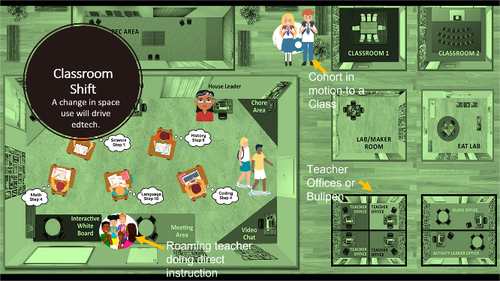
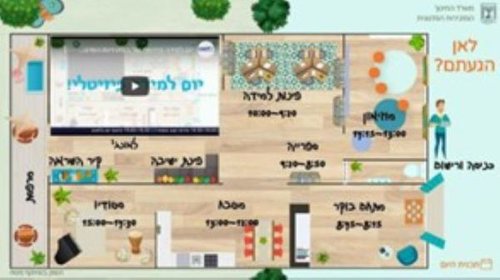
Small-batch manufacturing was then also inspected for its potentials to cause higher quality goods in education while also reducing overall costs and burdens. What was found is that small-batch design also added manufacturing flexibilities so that product innovation was faster.
The question arose: what if shorter-duration courses with specific objectives could be assigned in a custom package for students? Another angle, what if courses were themselves an out-moded derivative of whole-group mentality and teacher-centricity, and instead it is a lesson alone, a single goal or academic standard within it, that is the real building block of personalizing learning? It makes sense that smaller batches of learning things would bring more flexibility of crafting learning journeys. The open learning markets on the internet, Youtube and thousands of others, have already proven this modality works. Come to think of it, with learning more atomized but also well described and tagged, AI could not only provide personalized sequences by student but also innovative cross-curricular lessons and activities while pulling small groups together.
Signs that educational structure would undergo a similar transformation were found with model discussions also in Israel in 2020.
This line of thinking went further. What if the live moment of teaching, the lecture, the group discussion, the one-on-one help to understand denominators in math, the hands-on-project or lab was divorced from the materials study entirely? That would allow the “class” to be a meeting only. It would change teaching roles for sure, but it would not rid teaching of all of its legacy of methods like virtual learning entirely. When not in a live teaching moment, all other learning time could be in other spaces, perhaps flex spaces or even remote. Already the research was showing that more teachers were defining themselves as guides or facilitators and getting away from lecturing as much as possible anyway. The collective of human teaching appears to “feel” the future construct of their role and is in a slow-motion metamorphosis even if many education leaders are unaware.
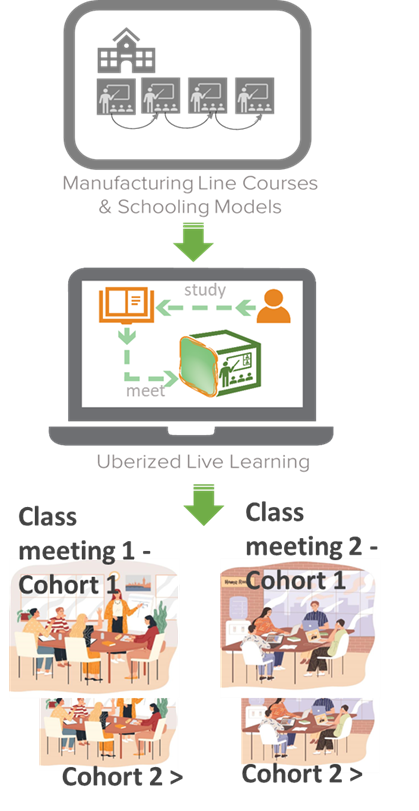
Smaller batches of student groupings also made sense because ability approximations mean groupings which derive healthy competition from similarity can be made. The age-old traditional schooling could finally alleviate the teaching pressure of the one-to-too-many whole group, which has too disparate ability levels, in favor of smaller groups. This observation led to the idea of how exactly auto-cohorting students across self-paced lesson sequences would have to work. Auto-cohorting was already inside some courseware by individual subjects, but it had never been applied as an overlay across everything, upending the whole master schedule.
Applying auto-cohorting for a large portion of the master schedule or all of it would uberize the learning.
Oh, the fun and horrors that were had working with time itself and algorithms to manage and allow more randomized patterns of human learning. Years and many, many weekends and late nights of my time with plenty of frustrations. Air traffic control at Chicago O’Hare may not be even two percent the equivalent of the complexities of tossing away a traditional school master schedule in favor of fully auto-cohorted learning in flexible space. Air traffic control would be easier than this.
Luckily, a brilliant mathematician appeared and a time-varying autoregression model for cohorting was built to run pattern discovery experiments for human schooling. A spatiotemporal AI was born enabling nonstationarity and time-varying behaviors, the patterns of which even allowed recommendations down to the level of curriculum effects.
Bringing it all Together to Solve Time & Space
Logistics and small-batch manufacturing aspects were then considered alongside what all the types of AI can now do, plus key parts of the rest of the edtech universe, for a quantum shift to full pathway personalization for every student that still intersects with live teaching. The last part of the journey was comparing certain efforts in traditional schooling versus how Hybrid Logistics Schooling would hypothetically work, and then formulating what would be needed for each to accomplish the metamorphosis.
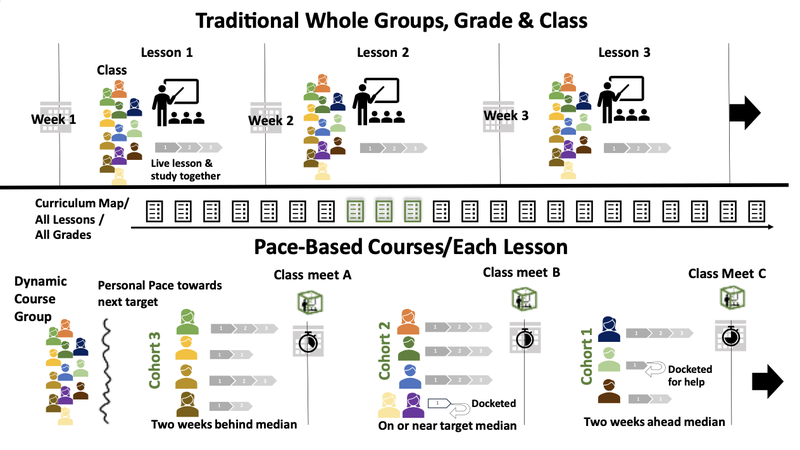
- Linear-to-Dynamic Schedules. Most educators in traditional schools agree there is a lot of wasted time, for both teachers and students, depending on how the schedule is run. Homeschoolers claim they can get the entirety of a similar seven-hour school day done in four or less hours at home. Today’s schools use master schedules and complexities like A-B days, A-B weeks, multiple tracks of hours use in blocked-off per day by subjects. The hidden waste is not the fact that these schedules operate linearly, but the fact that they force a normalization of time by whole groups and are only nominally customizable for the individual student.
Needed: AI calendaring built for schools which would create auto-cohorting meetings in non-traditional patterns of hour use as well as study schedules and teaching hours. This needed to be invented and has been now by Knowstory. The dynamics of using it include unforeseen network impacts and indicated a need for embedded AI (think IOT or internet of things), which is why schools are already working with Cisco for network readiness reviews as they learn of where this journey ends. There are other edtech dependencies probable such as digital signage and a normalization across a campus of all interactive whiteboards and other audio/visual enhancements for when cohorts come together for class meetings.
- Machiner-to-Master. Since schools are usually built like manufacturing plants, this term “machiner” to describe a teacher is apt for large portions of the job. The illusion is that the job is a form of art, helping students learn, but this is only a small part of the actual job in the present schooling form. Teachers are the “machiners” on the line, building lesson plans, grading and reporting on them. Hidden in this equation is also enormous amounts of time spent finding the things to put into the lesson plan and then tying them in to academic standards or goals and, in many schools, submitting these to administration.
Even when a school has a curriculum map it is usually only a map of academic standards tagged to the year’s schedule plus some “playlists” of potential learning things. The fact of the matter is that most of the “machining” for lesson building is done at the teacher level. The extra work to go from a curriculum map to actually building out each lesson and plotting them onto that map is not so great a leap to make for central subject matter experts (the masters), and is routinely what virtual schools do, just leaving out the live teaching aspect. Those lessons could still be modified, which is what most courseware companies and virtual schools offer in their complete-lesson modules. That this is not done across an entire curriculum but disaggregated down across 3.3 million machiners (teachers) nationally makes for a massive inefficiency and discontinuity in outcomes. Far less predictable results ensue than even the days of adopting textbooks which every teacher in a subject had to use.
Most teachers are expected to also machine their individual lessons in numerous ways to differentiate for learning disabilities or remediate for students way behind, and to personalize for each student even if not necessarily by wide breadths of pace (months, even years), at least by things like reading Lexile level. This is akin to one machiner having the job of thirty. While one teacher-machiner could maybe do the individualizations needed for a handful of students on top of leading several whole groups forward together totaling 150 or more students, when the numbers hit fifty or more the task is just not a human one to do well.
The ”machiner” was also not what any teacher usually envisioned when they decided to teach. They more likely to envision being a master of a subject and to confer that mastery. A lot of the workload, then, of the machining aspects needs to be removed.
Needed: Recommendations-engine AI, generative AI, both to reduce time provide higher quality outcomes through differentiation and personalization. Additionally, already crafted high-value courseware that includes animations and internally provides recommended resources and pathways needs to be used voraciously. Large learning object repositories (LORs) need to be available for teacher-masters to use for learning pathways created on the fly that swerve off the main learning roads into side lessons and whole side journeys because the Hybrid Logistics Schooling form will provide teachers more time for this. This is because the live teaching moment in the new form will be separated in time and space from the reading, watching, doing interactive courseware modules, writing and other asynchronous study.
- Distributors-to-Servicers. The distribution of learning resources is a one-to-many for every teacher. If a student doesn’t get the materials they need, having been somehow overlooked on a roster or email-send, a link doesn’t work, a computer is blocked from accessing a video, or a password fails, distribution takes on an exponential increase in traffic for the teacher. Individual questions being answered back and forth add even more traffic and teachers must be especially careful if they were to use group chats because students may inadvertently put in health information like “I had the flu and didn’t get this.” In group chat that could be like a disclosure of HIPPA sensitive information to all other students. There is also the issue of how complex digital can become versus the paper, book and projector past. Superintendents have been known to take calls after hours from frustrated parents who point out that their student cannot find assigned resources from teachers because of overly nested folders or misnamed documents in a poor schema of digital filing.
While there will always be some distribution aspects of learning resources to personalize by students, the gatekeeping and poor user interface aspects can largely be dispensed with. Digital framework systems, namely various lesson sequencers and learning management systems, can distribute the learning resources while also tracking pace and outcomes. Distribution would be all lessons end-to-end either as courses or custom sequenced for the individual student. Lessons would be punctuated by any needed live teaching moments. This would be, again, because in the new form the live teaching moments will be separated in time and space from asynchronous study. The live-teaching moments would not be meetings triggered as cohorts accrue.
Needed: Recommendations-engine AI, generative AI, both to reduce time provide higher quality outcomes through differentiation and personalization. Additionally, already great digital learning courseware which provides a lot of what the present generation of students, the Alpha Generation, expects in digital resources.
The full Hybrid Logistics Schema is a complex compilation of tech, the new form, the participants and the logistics of it all. This vision is not small, and will be layered over time with integrations, synchronizations and reporting for easy management.
The point of sharing this story on top of other writings, the many panel discussions at events, and podcasts, is that school leaders need to investigate this forthcoming shift in form. There are actions to take now to start their own journeys for the new form that will correctly fit their needs.
Read more here about the Hybrid Logistics Project.
Cisco Systems is a Strategic Vision Leadership member of the Hybrid Logistics Project produced by Learning Counsel News Media and Research. Knowstory is a Tactical Innovation Member.
***
Underwriters for the Hybrid Logistics Project

